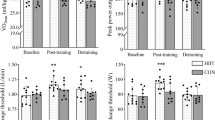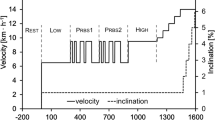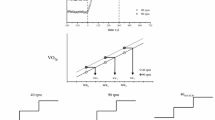Abstract
Purpose
This study examined the hypothesis that walking training (WT) could accelerate the slowed time constant (τ) of phase II in pulmonary oxygen uptake (\(\dot {V}\)O2) on-kinetics in older women. Also, we aimed to demonstrate that O2 delivery and O2 utilization were better matched at the site of gas exchange in exercising muscles when τ\(\dot {V}\)O2 was shortened.
Methods
20 recreationally active older women underwent WT sessions of approximately 60 min, 3–4 times a week for 12 weeks. We assessed \(\dot {V}\)O2, heart rate (HR) and deoxygenated-hemoglobin concentration ([HHb]) kinetics during a constant-load exercise test before training (0 week—Pre), and at 6 and 12 weeks (6 weeks—Mid, 12 weeks—Post) throughout the training period.
Results
Maximal oxygen uptake (\(\dot {V}\)O2max) was unchanged throughout the training program. τHR tended to decline at Mid (58.6 ± 22.0 s), and was significantly shorter at Post (51.7 ± 21.7 s, p = 0.01) compared to Pre (67.1 ± 23.8 s). τ\(\dot {V}\)O2 significantly decreased from 38.9 ± 8.6 s for Pre, to 31.5 ± 7.9 s for Mid (p = 0.02), and 32.3 ± 10.5 s for Post (p = 0.03). The normalized [HHb] to \(\dot {V}\)O2 ratio (Δ[HHb]/Δ\(\dot {V}\)O2) at Pre (1.32 ± 0.93) gradually approached the perfectly matched value (= 1.0) at Mid (1.15 ± 0.61) and Post (1.07 ± 0.52).
Conclusions
The restoration to baseline (≒ 30 s) of the slower τ\(\dot {V}\)O2 due to WT, which may reflect better matching of O2 delivery and O2 utilization at the site of gas exchange, suggests that a longer period of WT could be a useful tool for improving exercise tolerance in older individuals.


Similar content being viewed by others
Abbreviations
- ANOVA:
-
Analysis of variance
- BMI:
-
Body mass index
- bpm:
-
Beats per minute
- Δ[HHb]/Δ\(\dot {V}\)O2 :
-
Normalized muscle deoxygenation-hemoglobin concentration to pulmonary oxygen uptake ratio
- [HHb]:
-
Deoxygenated-hemoglobin concentration
- HR:
-
Heart rate
- Mid:
-
6 weeks after the start of training program
- NIRS:
-
Near-infrared spectroscopy
- η p 2 :
-
Partial eta squared
- PO:
-
Power output
- Post:
-
12 weeks after the start of training program
- Pre:
-
Before training program
- RER:
-
Respiratory exchange ratio
- rpm:
-
Revolutions per minute
- TD:
-
Time delay
- τ :
-
Time constant
- τ \(\dot {V}\)O2 :
-
Time constant of \(\dot {V}\)O2 in phase II
- \(\dot {V}\)CO2 :
-
Pulmonary carbon dioxide output
- \(\dot {V}\)O2 :
-
Pulmonary oxygen uptake
- \(\dot {V}\)E:
-
Pulmonary ventilation
- \(\dot {V}\)O2max :
-
Maximal oxygen uptake
- VT1 :
-
First ventilatory threshold
- W:
-
Watt
- W/H :
-
Waist-to-hip ratio
- WHO:
-
World Health Organization
- WT:
-
Walking training
References
Ayabe H, Hirakoba K (2015) Does advancing age linearly slow down the time constant of phase II in oxygen uptake kinetics during constant-load exercise? Gazz Med Ital 174:529–537
Babcock MA, Paterson DH, Cunningham DA (1994a) Effects of aerobic endurance training on gas exchange kinetics of older men. Med Sci Sports Exerc 26:447–452
Babcock MA, Paterson DH, Cunningham DA, Dickinson JR (1994b) Exercise on-transient gas exchange kinetics are slowed as a function of age. Med Sci Sports Exerc 26:440–446
Beaver WL, Wasserman K, Whipp BJ (1986) A new method for detecting anaerobic threshold by gas exchange. J Appl Physiol 60: 2020–2027
Belardinelli R, Georgiou D, Scocco V, Barstow TJ, Purcaro A (1995) Low intensity exercise training in patients with chronic heart failure. J Am Coll Cardiol 26:975–982
Bell C, Paterson DH, Kowalchuk JM, Moy AP, Thorp DB, Noble EG, Taylor AW, Cunningham DA (2001) Determinants of oxygen uptake kinetics in older humans following single-limb endurance exercise training. Exp Physiol 86:659–665
Cohen J (1988) The analysis of variance and covariance. In: Statistical power analysis for the behavioral sciences, 2nd edn. Lawrence Erlbaum Associates, Hillsdale, pp 273–406
DeLorey DS, Kowalchuk JM, Paterson DH (2004) Effect of age on O2 uptake kinetics and the adaptation of muscle deoxygenation at the onset of moderate-intensity cycling exercise. J Appl Physiol 97:165–172
DeLorey DS, Paterson DH, Kowalchuk JM (2007) Effects of ageing on muscle O2 utilization and muscle oxygenation during the transition to moderate-intensity exercise. Appl Physiol Nutr Metab 32:1251–1262 (review)
Dogra S, Spencer MD, Murias JM, Paterson DH (2013) Oxygen uptake kinetics in endurance-trained and untrained postmenopausal women. Appl Physiol Nutr Metab 38:154–160. https://doi.org/10.1139/apnm-2012-0173
Fukuoka Y, Grassi B, Conti M, Guiducci D, Sutti M, Marconi C, Cerretelli P (2002) Early effects of exercise training on on- and off-kinetics in 50-year-old subjects. Pflugers Arch 443:690–697
George MA, McLay KM, Doyle-Baker PK, Raylene A. Reimer RA, Murias JM (2018) Fitness level and not aging per se, determines the oxygen uptake kinetics response. Front Physiol March 29:9: 277. https://doi.org/10.3389/fphys.2018.00277
Grassi B (2006) Oxygen uptake kinetics: why are they so slow? And what do they tell us? J Physiol Pharmacol 57(Suppl 10):53–65
Grassi B, Gladden LB, Samaja M, Stary CM, Hogan MC (1998a) Faster adjustment of O2 delivery does not affect O2 on-kinetics in isolated in situ canine muscle. J Appl Physiol 85:1394–1403
Grassi B, Gladden LB, Stary CM, Wagner PD, Hogan MC (1998b) Peripheral O2 diffusion does not affect O2 on-kinetics in isolated insitu canine muscle. J Appl Physiol 85:1404–1412
Grey TM, Spencer MD, Belfry GR, Kowalchuk JM, Paterson DH, Murias JM (2015) Effects of age and long-term endurance training on O2 kinetics. Med Sci Sports Exerc 47:289–298. https://doi.org/10.1249/MSS.0000000000000398
Gurd BJ, Scheid J, Paterson DH, Kowalchuk JM (2007) O2 uptake and muscle deoxygenation kinetics during the transition to moderate-intensity exercise in different phases of the menstrual cycle in young adult females. Eur J Appl Physiol 101:321–330
Hamasaki A, Arima S, Mitsuzono R, Hirakoba K (2015) Effect of low-intensity training on transient kinetics of pulmonary oxygen uptake during moderate-intensity cycle exercise. J Sports Med Phys Fit 55:1072–1081
Henriksson J, Hickner RC (1998) Adaptations in skeletal muscle in response to endurance training. In: Oxford textbook of sports medicine, 2nd edn. Oxford, New York, pp 45–69
Hughson RL, Tschakovsky ME, Houston ME (2001) Regulation of oxygen consumption at the onset of exercise. Exerc Sport Sci Rev 29:129–133
Kashima S (2003) Spectroscopic measurement of blood volume and its oxygenation in a small volume of tissue using red laser lights and differential calculation between two point detections. Opt Laser Technol 35:485–489. https://doi.org/10.1016/S0030-3992(03)00066-5
Laplaud D, Guinot M, Favre-Juvin A, Flore P (2006) Maximal lactate steady state determination with a single incremental test exercise. Eur J Appl Physiol 96:446–452. https://doi.org/10.1007/s00421-005-0086-4
Mac Ananey O, Malone J, Warmington S, O’Shea D, Green S, Egaña M (2011) Cardiac output is not related to the slowed O2 uptake kinetics in type 2 diabetes. Med Sci Sports Exerc 43:935–942. https://doi.org/10.1249/MSS.0b013e3182061cdb
McLay KM, Murias JM, Paterson DH (2017) Similar pattern of change in V̇o2 kinetics, vascular function, and tissue oxygen provision following an endurance training stimulus in older and young adults. Am J Physiol Regul Integr Comp Physiol 312:R467–R476. https://doi.org/10.1152/ajpregu.00399.2016
Mezzani A, Grassi B, Giordano A, Corrà U, Colombo S, Giannuzzi P (2010) Age-related prolongation of phase I of O2 on-kinetics in healthy humans. Am J Physiol Regul Integr Comp Physiol 299:R968–R976. https://doi.org/10.1152/ajpregu.00739.2009
Murias JM, Paterson DH (2015) Slower O2 kinetics in older individuals: is it inevitable? Med Sci Sports Exerc 47:2308–2318. https://doi.org/10.1249/MSS.0000000000000686 (review)
Murias JM, Kowalchuk JM, Paterson DH (2010) Speeding of O2 kinetics with endurance training in old and young men is associated with improved matching of local O2 delivery to muscle O2 utilization. J Appl Physiol 108:913–922. https://doi.org/10.1152/japplphysiol.01355.2009
Murias JM, Kowalchuk JM, Paterson DH (2011a) Speeding of O2 kinetics in response to endurance-training in older and young women. Eur J Appl Physiol 111:235–243. https://doi.org/10.1007/s00421-010-1649-6
Murias JM, Spencer MD, Kowalchuk JM, Paterson DH (2011b) Influence of phase I duration on phase II VO2 kinetics parameter estimates in older and young adults. Am J Physiol Regul Integr Comp Physiol 301:R218–R224. https://doi.org/10.1152/ajpregu.00060.2011
Murias JM, Spencer MD, Delorey DS, Gurd BJ, Kowalchuk JM, Paterson DH (2011c) Speeding of O2 kinetics during moderate-intensity exercise subsequent to heavy-intensity exercise is associated with improved local O2 distribution. J Appl Physiol 111:1410–1415. https://doi.org/10.1152/japplphysiol.00607.2011
Murias JM, Spencer MD, Kowalchuk JM, Paterson DH (2011d) Muscle deoxygenation to O2 relationship differs in young subjects with varying τO2. Eur J Appl Physiol 111:3107–3118. https://doi.org/10.1007/s00421-011-1937-9
Murias JM, Spencer MD, Paterson DH (2014) The critical role of O2 provision in the dynamic adjustment of oxidative phosphorylation. Exerc Sport Sci Rev 42:4–11. https://doi.org/10.1249/JES.0000000000000005 (review)
Murias JM, Edwards JA, Paterson DH (2015) Effects of short-term training and detraining on VO2 kinetics: faster VO2 kinetics response after one training session. Scand J Med Sci Sports 26:620–629. https://doi.org/10.1111/sms.12487
Örlander J, Kiessling KH, Karlsson J, Ekblom B (1977) Low intensity training, inactivity and resumed training in sedentary men. Acta Physiol Scand 101:351–362
Örlander J, Kiessling KH, Ekblom B (1980) Time course of adaptation to low intensity training in sedentary men: dissociation of central and local effects. Acta Physiol Scand 108:85–90
Parker BA, Smithmyer SL, Pelberg JA, Mishkin AD, Proctor DN (2008) Sex-specific influence of aging on exercising leg blood flow. J Appl Physiol 104:655–664
Phillips SM, Green HJ, MacDonald MJ, Hughson RL (1995) Progressive effect of endurance training on O2 kinetics at the onset of submaximal exercise. J Appl Physiol 79:1914–1920
Poole DC, Jones AM (2012) Oxygen uptake kinetics. Compr Physiol 2:933–996. https://doi.org/10.1002/cphy.c100072 (review)
Poole DC, Barstow TJ, McDonough P, Jones AM (2008) Control of oxygen uptake during exercise. Med Sci Sports Exerc 40:462–474. https://doi.org/10.1249/MSS.0b013e31815ef29b (review)
Proctor DN, Koch DW, Newcomer SC, Le KU, Leuenberger UA (2003a) Impaired leg vasodilation during dynamic exercise in healthy older women. J Appl Physiol 95:1963–1970
Proctor DN, Newcomer SC, Koch DW, Le KU, MacLean DA, Leuenberger UA (2003b) Leg blood flow during submaximal cycle ergometry is not reduced in healthy older normally active men. J Appl Physiol 94:1859–1869
Shono N, Urata H, Saltin B, Mizuno M, Harada T, Shindo M, Tanaka H (2002) Effects of low intensity aerobic training of skeletal muscle capillary and blood lipoprotein profile. J Atheroscler Thrombs 9:78–85
Spencer MD, Murias JM, Lamb HP, Kowalchuk JM, Paterson DH (2011) Are the parameters of VO2, heart rate and muscle deoxygenation kinetics affected by serial moderate-intensity exercise transitions in a single day? Eur J Appl Physiol 111:591–600. https://doi.org/10.1007/s00421-010-1653-x
Spencer MD, Gravelle BM, Murias JM, Zerbini L, Pogliaghi S, Paterson DH (2013) Duration of “Phase I” VO2p: a comparison of methods used in its estimation and the effects of varying moderate-intensity work rate. Am J Physiol Regul Integr Comp Physiol 304:R238–R247. https://doi.org/10.1152/ajpregu.00419.2012
Stathokostas L, Kowalchuk JH, Paterson DH (2013) Influence of hormone replacement therapy and aerobic exercise training on oxygen uptake kinetics in postmenopausal women. Appl Physiol Nutr Metab 38:657–665. https://doi.org/10.1139/apnm-2012-0421 (epub 2013 Jan 24)
Tschakovsky ME, Hughson RL (1999) Interaction of factors determining oxygen uptake at the onset of exercise. J Appl Physiol 86:1101–1113 (review)
Whipp BJ, Ward SA, Lamarra N, Davis JA, Wasserman K (1982) Parameters of ventilatory and gas exchange dynamics during exercise. J Appl Physiol Respir Environ Exerc Physiol 52:1506–1513
World Health Organization (2010) Recommended population levels of physical activity for health. Global recommendations on physical activity for health, pp 15–33. http://apps.who.int/iris/bitstream/10665/44399/1/9789241599979_eng.pdf. Accessed 7 Dec 2016
Acknowledgements
The authors are grateful to the participants for the time and effort they dedicated to this study. We would also like to thank the staff of Katsuura Orthopaedics Clinic and Katsuura Sports Club for their assistance with the experiment.
Funding
None.
Author information
Authors and Affiliations
Contributions
AH and KH conceived and designed the research; AH and SA performed experiments; AH and SA analyzed data; AH and KH interpreted results of experiments; AH prepared figures and tables; AH and SA drafted manuscript; KH edited and revised manuscript; AH, SA and KH approved final version of manuscript.
Corresponding author
Ethics declarations
Conflict of interest
The authors declare that they have no conflict of interest.
Additional information
Communicated by Susan Hopkins.
Rights and permissions
About this article
Cite this article
Hamasaki, A., Arima, S. & Hirakoba, K. Changes in pulmonary oxygen uptake and muscle deoxygenation kinetics during cycling exercise in older women performing walking training for 12 weeks. Eur J Appl Physiol 118, 2179–2188 (2018). https://doi.org/10.1007/s00421-018-3946-4
Received:
Accepted:
Published:
Issue Date:
DOI: https://doi.org/10.1007/s00421-018-3946-4




